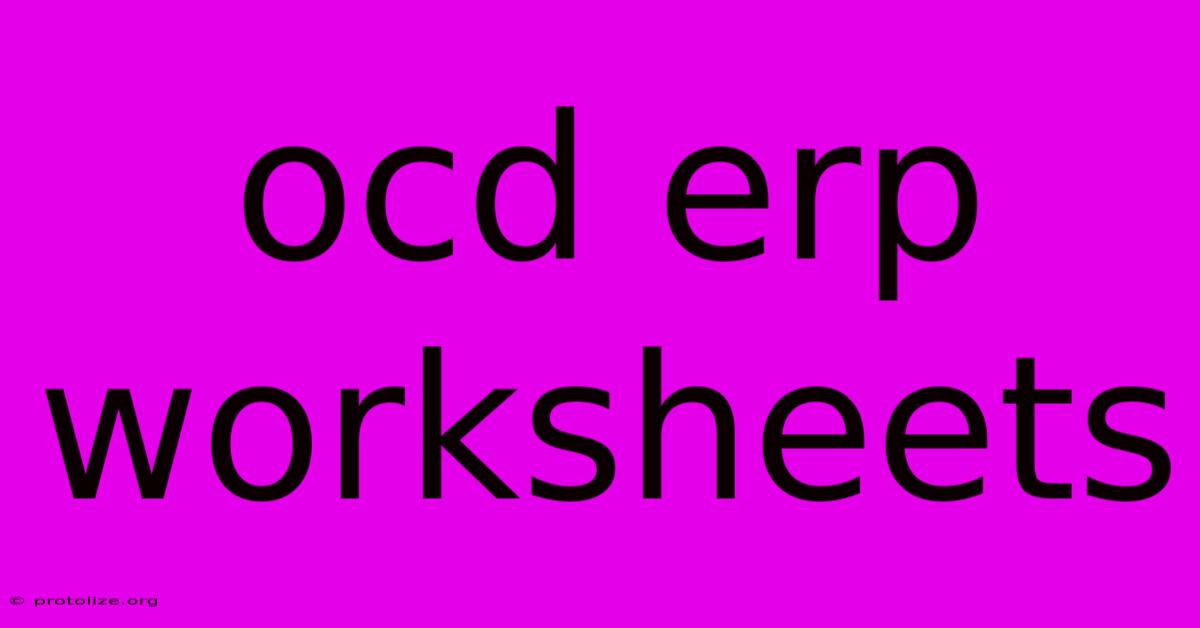Ocd Erp Worksheets

Discover more detailed and exciting information on our website. Click the link below to start your adventure: Visit Best Website mr.cleine.com. Don't miss out!
Table of Contents
OCD ERP Worksheets: Your Guide to Managing Obsessions and Compulsions
Obsessive-Compulsive Disorder (OCD) can be incredibly challenging, characterized by intrusive thoughts (obsessions) and repetitive behaviors or mental acts (compulsions) designed to neutralize those thoughts. Exposure and Response Prevention (ERP) therapy is a highly effective treatment for OCD, and using ERP worksheets can significantly enhance its effectiveness. These worksheets provide a structured approach to gradually facing your fears and resisting compulsions. This guide will explore the importance of OCD ERP worksheets and how to utilize them effectively.
Understanding OCD and ERP Therapy
Before diving into the specifics of worksheets, let's briefly revisit the core principles of OCD and ERP. OCD involves a cycle: an obsession triggers anxiety, leading to a compulsion to reduce that anxiety. While the compulsion provides temporary relief, it reinforces the obsession in the long run.
ERP therapy directly challenges this cycle. Exposure involves gradually confronting the feared situations or thoughts that trigger obsessions. Response Prevention means actively resisting the urge to perform compulsions. This process helps break the connection between obsessions and compulsions, reducing anxiety over time.
The Power of OCD ERP Worksheets
OCD ERP worksheets act as a roadmap for your ERP therapy. They provide a structured way to:
- Track your obsessions and compulsions: Identifying patterns in your thoughts and behaviors is crucial for understanding your OCD triggers.
- Develop an exposure hierarchy: This involves ranking your feared situations or thoughts from least to most anxiety-provoking. Starting with less anxiety-inducing exposures helps you build confidence and gradually work your way up.
- Plan and schedule your exposures: Worksheets provide a space to detail your exposure sessions, including the specific situation, duration, and anticipated anxiety level.
- Monitor your anxiety levels: Tracking your anxiety before, during, and after exposure helps you gauge your progress and adjust your plan as needed.
- Analyze your responses: Worksheets help you reflect on your experiences, identifying triggers, coping mechanisms, and areas for improvement.
How to Use OCD ERP Worksheets Effectively
While the specific format of ERP worksheets can vary, most include sections for:
1. Identifying Obsessions and Compulsions
- List your obsessions: Write down all your intrusive thoughts, even if they seem irrational or embarrassing. Be specific and detailed.
- List your compulsions: Note the specific behaviors or mental acts you perform to neutralize your obsessions. Again, be detailed.
- Connect obsessions and compulsions: Identify which obsession triggers each compulsion.
2. Creating an Exposure Hierarchy
- Rank your fears: List your feared situations or thoughts in order of increasing anxiety, from least to most distressing. This allows for a gradual approach.
- Break down large fears: Divide overwhelming fears into smaller, more manageable steps. For example, instead of immediately facing a large social gathering, you might start with a smaller, less intimidating social interaction.
3. Planning and Scheduling Exposures
- Choose a specific exposure: Select an item from your hierarchy to begin with.
- Set a time limit: Determine how long you will engage in the exposure. Start with short durations and gradually increase the time.
- Schedule your exposure: Set a specific date and time to complete the exposure. Consistency is key.
4. Monitoring Anxiety and Responses
- Rate your anxiety: Before, during, and after each exposure, rate your anxiety level on a scale (e.g., 0-10).
- Record your thoughts and feelings: Note any thoughts, feelings, or physical sensations you experience during the exposure.
- Analyze your responses: After each exposure, reflect on your experience. Did your anxiety decrease over time? Did you resist the urge to perform compulsions?
5. Review and Adjust Your Plan
Regularly review your worksheet entries to track your progress and identify areas needing adjustment. You may need to modify your exposure hierarchy, time limits, or coping strategies based on your experience.
Finding and Using OCD ERP Worksheets
While you can find many examples online, it's crucial to work with a qualified therapist specializing in OCD and ERP therapy. A therapist can help you create personalized worksheets tailored to your specific needs and guide you through the process, providing support and encouragement throughout. They can also help you address any challenges you encounter and ensure you're using the worksheets effectively.
Remember: ERP therapy is not a quick fix. It requires consistent effort and patience. Using OCD ERP worksheets can significantly aid in this process, providing a structured and effective way to manage your OCD symptoms and improve your quality of life. With the right support and dedication, you can overcome the challenges of OCD and lead a fulfilling life.

Thank you for visiting our website wich cover about Ocd Erp Worksheets. We hope the information provided has been useful to you. Feel free to contact us if you have any questions or need further assistance. See you next time and dont miss to bookmark.
Featured Posts
-
Man Utd Wins Hojlund Scores Vs Plzen
Dec 13, 2024
-
Booming Wi Fi As A Service Market Forecast
Dec 13, 2024
-
Technical Glitch Facebook Instagram Offline
Dec 13, 2024
-
Who Use Erp
Dec 13, 2024
-
Customized Erp Software India
Dec 13, 2024
